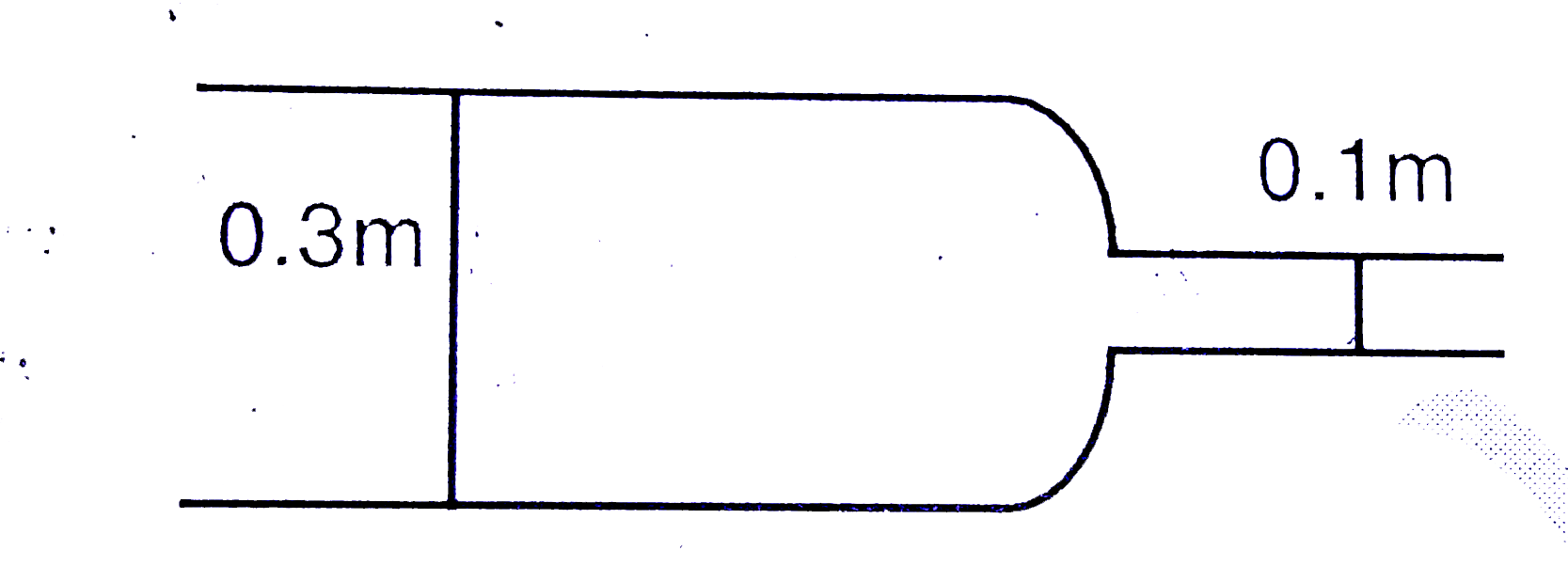A venturimeter has a threat of diameter 0-06 m. The diameter of the horizontal pipeline where the venturimeter is inserted is 0-1 m. The pressure difference between the mainline and the throat is 0-32 of water. Calculate the rate of now of water in the pipeline. ?
To solve the problem, we will follow these steps:
Step 1: Identify the Given Data
- Diameter of the throat (d1) = 0.06 m
- Diameter of the pipeline (d2) = 0.1 m
- Pressure difference (ΔP) = 0.32 m of water
- Density of water (ρ) = 1000 kg/m³
- Acceleration due to gravity (g) = 9.81 m/s²
Step 2: Calculate the Areas of the Throat and the Pipeline
The area (A) of a circular cross-section can be calculated using the formula:
A=πd24
1. Area of the throat (A1):
A1=π(0.06)24=π(0.0036)4≈0.002827m2
2. Area of the pipeline (A2):
A2=π(0.1)24=π(0.01)4≈0.007854m2
Step 3: Convert the Pressure Difference to Pascals
To convert the pressure difference from meters of water to Pascals, use the formula:
ΔP=height×ρ×g
ΔP=0.32×1000×9.81≈3139.2Pa
Step 4: Apply Bernoulli's Equation
Using Bernoulli's equation between the two points (throat and pipeline):
P1+12ρV21=P2+12ρV22
Rearranging gives:
12ρV21−12ρV22=P2−P1=−ΔP
Step 5: Use the Continuity Equation
The continuity equation states:
A1V1=A2V2
From this, we can express V1 in terms of V2:
V1=A2A1V2
Step 6: Substitute V1 in Bernoulli's Equation
Substituting V1 into the rearranged Bernoulli's equation:
12ρ(A2A1V2)2−12ρV22=−ΔP
Step 7: Simplify and Solve for V2
Factor out 12ρ:
12ρ(A22A21V22−V22)=−ΔP
This simplifies to:
12ρV22(A22A21−1)=−ΔP
Rearranging gives:
V22=−2ΔPρ(A22A21−1)
Step 8: Calculate the Rate of Flow
The rate of flow Q is given by:
Q=A2V2
Step 9: Substitute Values and Calculate
1. Calculate V2 using the values of ΔP, A1, and A2.
2. Finally, calculate Q.
Final Calculation
1. Substitute the values into the equations derived.
2. Calculate V2.
3. Calculate Q.
- Diameter of the throat (d1) = 0.06 m
- Diameter of the pipeline (d2) = 0.1 m
- Pressure difference (ΔP) = 0.32 m of water
- Density of water (ρ) = 1000 kg/m³
- Acceleration due to gravity (g) = 9.81 m/s²
The area (A) of a circular cross-section can be calculated using the formula:
A=πd24
A1=π(0.06)24=π(0.0036)4≈0.002827m2
A2=π(0.1)24=π(0.01)4≈0.007854m2
To convert the pressure difference from meters of water to Pascals, use the formula:
ΔP=height×ρ×g
Using Bernoulli's equation between the two points (throat and pipeline):
P1+12ρV21=P2+12ρV22
12ρV21−12ρV22=P2−P1=−ΔP
The continuity equation states:
A1V1=A2V2
From this, we can express V1 in terms of V2:
V1=A2A1V2
Substituting V1 into the rearranged Bernoulli's equation:
12ρ(A2A1V2)2−12ρV22=−ΔP
Factor out 12ρ:
12ρ(A22A21V22−V22)=−ΔP
12ρV22(A22A21−1)=−ΔP
V22=−2ΔPρ(A22A21−1)
The rate of flow Q is given by:
Q=A2V2
1. Calculate V2 using the values of ΔP, A1, and A2.
2. Finally, calculate Q.
1. Substitute the values into the equations derived.
2. Calculate V2.
3. Calculate Q.
Topper's Solved these Questions
- MOTION IN FLUIDS BOOK - ICSECHAPTER - MOTION IN FLUIDS EXERCISE - CONCEPTUAL SHORT ANSWER QUESTIONS WITH ANSWERS
16 Videos
- MOTION IN FLUIDS BOOK - ICSECHAPTER - MOTION IN FLUIDS EXERCISE - LONG ANSWER QUESTIONS
5 Videos
- INTERNAL ENERGY BOOK - ICSECHAPTER - INTERNAL ENERGY EXERCISE - SELECTED PROBLEMS (FROM HEAT ENGINES)
21 Videos
- OSCILLATIONS BOOK - ICSECHAPTER - OSCILLATIONS EXERCISE - SELECTED PROBLEMS (OSCILLATION IN A TUNNEL BORED THROUGH THE EARTH)
2 Videos
Similar Questions
A pipe is running full of water. At a certain point A It tapers from 60 cm diameter to 20 cm at B. The pressure difference between A and B is 1 m of water column. Find the rate of flow of water through the pipe.
View SolutionA pitot tube is fixed in a water pipe of diameter 14cm and difference of pressure by the gauge is 20cm of water column. Calculate the rate of flow of water.
View SolutionWater is flowing in a non viscous tube as shown in the diagram. The diametre at a point A and B are 0.5m and 0.1m respectively. The pressure difference between points A & B are △P=0.8 then find out the rate of flow:

View SolutionA glass U-tube is such that the diameter of one limb is 3.0mm and that of the other is 6.0mm. The tube is inverted vertically with the open ends below the surface of water in a beaker. What is the difference between the height to which water rises in the two limbs? Surface tension of water is 0.07Nm−1. Assume that the angle of contact between water and glass is 0∘.
View SolutionA spherical drop of water has 1 mm radiusHf the surface tension of water is 75×10−3 N/m, then difference of pressure between inside and outside of the drop is
View SolutionWater is nowing through a horizontal pipe of varying cross-section. At a certain point where the velocity is 0-24 m/s the pressure of water is 0-010 metre of mercury. What is the pressure at a point where the velocity is 0−48ms?
View SolutionIn an experimental model of the venturimeter, the diameter of the pipe is 4 cm and that of constriction is 3 cm. With water filling the pipe and flowing at a certain rate the height of the liquids in the pressure tube is 20 cm at the pipe and 15 cm at the constrictions. what is the discharge rate ?
View SolutionA uniform wire of length 8m and diameter 0.6mm stretched by 4mm under a certain force. If the Poisson's ratio of the material of the wrie is 0.3, calculate the change in diameter of the wire.
View SolutionWater is maintained at a height of 10 min a tank. Calculate the diameter of orifice needed at the base of the tank to discharge water at the rate of 26.4m3 per minute.
View SolutionA wire 0.1m long is placed horizontally on the surface of water and is gently pulled up with a force of 1.456×10−2N to keep the wire in equilibrium. Calculate the surface tension of water.
View Solution
